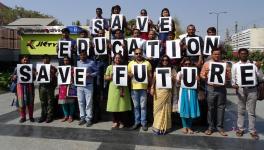10 Years of Modi: Food & Nutrition Schemes Run on Crumbs of Budget Pie

Representational image.
New Delhi: Is the free ration scheme for 81 crore poor families (launched during Covid-19 and extended for another five years now) a ‘badge of honour’ or a ‘black spot’ on the world’s fastest growing economy? Why does India still rank 111 out of 125 countries in the Global Hunger index in 2023? Why are 32% of India’s children still underweight, as per the government’s own figures?
These and other questions on the Narendra Modi-led BJP government’s promises and claims in 10 years of its rule are part of the “Food Security and Nutrition Report Card 2014-24” brought out by Financial Accountability Network India (FAN India), a collective of civil society organisations, unions, people’s movements and concerned citizens.
The report card, prepared mainly after perusing government documents and statements, cites BJP’s 2014 election manifesto that had claimed that “BJP is committed to addressing the issues related to children, like malnutrition and undernutrition.”
But what is the reality after 10 years of Modi rule?
“Latest National Family Health Survey (NHFS) shows in India, 36% of children under age five years are stunted (or too short for their age). The report itself says that it is a “sign of chronic undernutrition.” 32% of children under age five years are underweight,” says the report card.
It points out that despite initiatives like Anaemia Mukta Bharat in 2018, the incidence of anaemia among women aged 15- 49 years has increased from 53% in 2015-16 to 57.2% in 2019-20, as per the NHFS.
In fact, 67% of children had some degree of anaemia (haemoglobin level below 11). What’s more, during Modi’s regime, between 2015-16 and 2019-21, “the prevalence of anaemia among children aged 6-59 months had increased from 59% to 67%”.
In Gujarat, Modi’s home state, which was much-hyped as a ‘model state’ during the 2014 Lok Sabha election campaign, the prevalence of anaemia among children aged 6.59 is the highest at 80%!
According to NFHS-5, the most affected districts are Narmada (93.2%), Panchmahal (91%), and Aravalli (89.5%).
Among the poor population in both urban and rural areas, the worst off in terms of food security are the marginalised communities, such as the Scheduled Castes (SCs) and Scheduled Tribes (STs).
The FAN-India report card, citing a study by economist Dipa Sinha after going through NHFS data, points out that “while the prevalence of stunting among SCs and STs is around 40 per cent, it is 30 per cent among children belonging to the “Others” group, which mainly consists of upper-caste Hindus.”
It also cited a report on a study by JAMA Network Open Journal in February 2024, that showed India ranking third in the number of children aged 6-23 months “who had not eaten any food in the past 24 hours.”
In this backdrop, should not the government’s allocation for schemes that directly affect mother and child nutrition have increased?
What is the reality of government expenditure under Modi?
For one, the Mid-Day Meal Scheme, now renamed PM-Poshan, has seen a decline from 0.79% 2013-14 to 0.23% in 2024-25.
In addition, the “saffronisation of food has led to children across many states being deprived of eggs in their mid-day meals. Eggs provide essential nutritional supplements that can help tackle issues of stunting, wasting and undernutrition among children,” says the report card.
No wonder, among other reasons, between NHFS-4 and NHFS-5, the incidence of stunting among children has increased in 21 states.
On allocation for Pradhan Mantri Matru Vandana Yojana, the report card cites a RTI reply saying that the number of beneficiaries has declined from 96 lakh in 2019-20 to 61 lakh in 2021-22.
“Currently, women under this scheme receive only Rs 5,000 compared to Rs 6,000 mandated under the National Food Security Act,” it notes.
The services of Anganwadi women and helpers across the country, who are crucial for taking care and monitoring child nutrition and health, are cracking under the pressure of unfilled vacancies and inadequate honorarium and benefits.
According to government’s own data, 70,444 positions for Anganwadi workers and 1,23,287 positions for helpers are lying vacant across the country.
In addition, there has been a 3.33% decline in the budget allocation for food subsidies under the Public Distribution System for 2024-25 to Rs 2.05 lakh crore from the revised estimates of Rs. 2.12 lakh crore for 2023-24.
And the portion of the overall budget allocated to food subsidies has decreased steadily in the 10 years of Modi rule, from 6.4% in 2014-15 to 4.3% in 2024-25.
The Modi government, while extending the 5 kg free foodgrain to targeted families under Pradhan Mantri Garib Kalyan Anna Yojana this January, had said it was “a historic decision that reflects the dedication and commitment of the Hon. Prime Minister of India, Shri Narendra Modi, towards strengthening food and nutrition security in the Country.” However, this report card’s perusal of government’s own data and allocations tells a different story. Can ‘Bharat’ think of being ‘Viksit’ if a big chunk of its future – its children, are underweight and stunted?
Get the latest reports & analysis with people's perspective on Protests, movements & deep analytical videos, discussions of the current affairs in your Telegram app. Subscribe to NewsClick's Telegram channel & get Real-Time updates on stories, as they get published on our website.
























